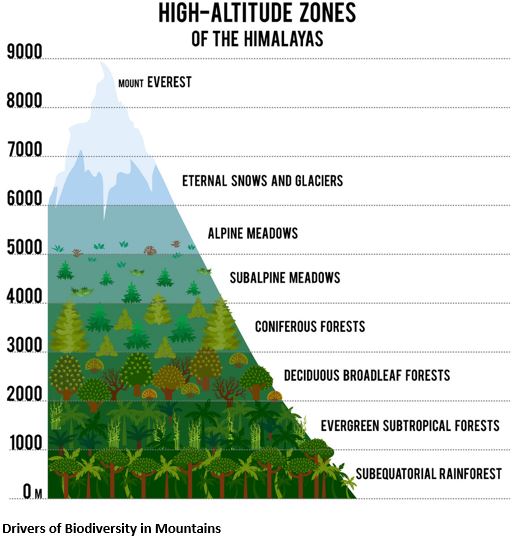Explorers and naturalists, including Alexander von Humboldt, have long pondered the factors influencing biodiversity, especially in mountainous regions. Humboldt's observations in South America laid the foundation for understanding the intricate relationship between temperature, altitude, humidity, and species distribution.
Humboldt’s Enigma: Mountains Defying Tropical Norms
- The Tropics and Beyond
- Tropical areas receive more solar energy, fostering greater biodiversity.
- Contrary to expectations, mountains challenge this norm by maintaining high biodiversity outside the tropics.
- Indian Perspective: Eastern Himalaya vs. Western Ghats
- While tropical areas like the Western Ghats are biodiversity hotspots, the eastern Himalaya surpasses them in diversity, especially in perching and river birds.
|
|
Eastern Himalayas
|
Western Ghats
|
|
Location
|
The Eastern Himalayas are situated in the northeastern part of India, extending across states like Sikkim, Arunachal Pradesh, and parts of Assam.
|
The Western Ghats run parallel to the western coast of India, spanning states like Maharashtra, Goa, Karnataka, Kerala, and Tamil Nadu.
|
|
Height
|
This region includes some of the highest peaks globally, such as Kanchenjunga, the third-highest mountain in the world.
|
Generally lower in elevation compared to the Himalayas, but still containing peaks over 2,000 meters.
|
|
Formation
|
Formed due to the collision of the Indian and Eurasian tectonic plates.
|
Formed due to the break-up of the supercontinent Gondwana and subsequent volcanic activity.
|
|
Biodiversity
|
Renowned for its rich biodiversity, with a wide variety of flora and fauna, including unique species like the red panda and the Bengal tiger.
|
Recognized as a biodiversity hotspot, home to numerous endemic species, including the endangered lion-tailed macaque.
|
|
Cultural Significance
|
Home to diverse ethnic communities with distinct cultures and traditions.
|
Features diverse ethnic communities and holds cultural importance with historic forts and temples.
|
|
Rivers
|
Numerous major rivers, including the Brahmaputra, Ganges, and their tributaries, originate in the Eastern Himalayas.
|
Origin of several rivers, such as the Godavari, Krishna, and Kaveri.
|

Drivers of Biodiversity in Mountains
1. Geological Processes: Cradles and Museums
- Mountains act as 'cradles' with geological processes creating new habitats.
- Some mountains serve as 'museums,' preserving species due to climatic stability over time.
|
Himalayas as Museums:
The Himalayan Mountains are indeed considered "museums" of fossils and geological evidence, providing a window into the Earth's past. The ongoing collision between the Indian and Eurasian tectonic plates that formed the Himalayas has exposed layers of rocks dating back to different geological epochs. Here are some notable examples of fossils and evidence found in the Himalayas:
1. Fossilized Marine Life:
- In the higher reaches of the Himalayas, particularly in regions like Kashmir and Ladakh, marine fossils dating back to the Tethys Sea, which once existed between the Indian and Eurasian plates, have been discovered. These fossils include marine invertebrates, indicating the ancient presence of oceans in the region.
2. Tethyan Sediments:
- The Himalayas contain extensive deposits of sediments from the Tethyan geological era, offering insights into the history of the region. These sediments often contain evidence of past environmental conditions, helping scientists reconstruct the ancient climate and ecosystems.
3. Plant Fossils:
- Fossilized plant remains, including leaves and wood, have been unearthed in the Himalayas. These fossils provide information about the flora that existed in the region during different geological periods, aiding in understanding the evolution of plant life.
4. Glacial Evidence:
- Glacial landforms and features in the Himalayas offer evidence of past glacial activity. Studying these formations helps scientists reconstruct the history of ice ages and climatic fluctuations in the region.
5. Sedimentary Rocks:
- Various types of sedimentary rocks, including shale, limestone, and sandstone, found in the Himalayas carry clues about the depositional environments and geological processes that shaped the landscape over millions of years.
6. Tectonic Evidence:
- The Himalayas are a dynamic geological zone with ongoing tectonic activity. The exposed rock formations and fault lines provide direct evidence of the intense tectonic forces shaping the region.
|
2. Coastal Tropical Sky Islands
- Examples like Shola Sky Islands illustrate how old lineages persist, housing ancient bird species.
|
Sky Island:
- Sky islands are isolated mountains surrounded by radically different lowland environments.
- The term originally referred to those found on the Mexican Plateau, and has extended to similarly isolated high-elevation forests.
- The isolation has significant implications for these natural habitats.
- The American Southwest region began warming up between c. 20,000 and 10,000 years BP and atmospheric temperatures increased substantially, resulting in the formation of vast deserts that isolated the sky islands.
- Endemism, altitudinal migration, and relict populations are some of the natural phenomena to be found on sky islands.
Sky Islands of Western Ghats
- The Western Ghats are a mountain chain in southwest India home to spectacular and unique sky islands.
- The peaks of the Western Ghats, ranging between 3,000 and 8,500 feet above sea level, host an almost unbelievable array of microclimates, looking like “patches of forests floating in a sea of grasslands.
Treasures of Shola
- One of the specific habitats unique to the sky islands of this area is a type of low-temperature, high-humidity tropical cloud forest full of stunted trees mixed with grasslands called the Shola.
- The Shola forests of South derive their name from the Tamil word solai, which means a ‘tropical rain forest’.
- Classified as ‘Southern Montane Wet Temperate Forest’ the Sholas are found in the upper reaches of the Nilgiris, Anamalais, Palni hills, Kalakadu, Mundanthurai and Kanyakumari in the states of Tamil Nadu and Kerala.
- These forests are found sheltered in valleys with sufficient moisture and proper drainage, at an altitude of more than 1,500 metres.
|
3. Geological Heterogeneity
- Mountains with diverse geological compositions exhibit higher biodiversity, especially in the tropics.
|
India is endowed with a diverse and complex geological framework, and its mountainous regions exhibit significant geological heterogeneity. Here are some key aspects of the geological heterogeneity in the Indian mountains:
1. Himalayan Range:
- The Himalayas, the youngest and tallest mountain range in the world, are primarily composed of young folded sedimentary rocks, metamorphic rocks, and intrusions of granite. The collision between the Indian and Eurasian tectonic plates led to the uplift of the Himalayas.
2. Aravalli Range:
- The Aravalli Range, one of the oldest mountain ranges globally, showcases ancient rocks dating back to the Proterozoic era. It contains sedimentary and metamorphic rocks, including quartzite and marble.
3. Western Ghats:
- The Western Ghats are characterized by a mix of different rock types, including basalt flows from volcanic activity, ancient Precambrian rocks, and sedimentary rocks. The region has diverse geological formations due to its complex geological history.
4. Eastern Ghats:
- The Eastern Ghats are primarily composed of ancient granites, gneisses, and other metamorphic rocks. Unlike the Western Ghats, the Eastern Ghats are not associated with extensive volcanic activity.
5. Vindhyan Range:
- The Vindhyan Range is known for its extensive sedimentary rock formations, including sandstone, shale, and limestone. These rocks provide insights into the ancient history of the Indian subcontinent.
6. Satpura Range:
- The Satpura Range exhibits a variety of rock types, including sandstone, shale, and limestone. It also contains igneous intrusions and some volcanic rocks, contributing to the geological diversity of the region.
7. Deccan Plateau:
- The Deccan Plateau, which includes the Deccan Traps, is characterized by extensive basaltic lava flows. The Deccan Traps resulted from volcanic activity that occurred around 66 million years ago and played a significant role in the geological history of the Indian subcontinent.
8. Siwalik Range:
- The Siwalik Range, the outermost range of the Himalayas, consists of unconsolidated sedimentary rocks such as sandstone, siltstone, and conglomerates. Fossils found in Siwalik rocks provide valuable information about the region's paleontological history.
|
4. Climate Dissimilarity
- Climate differences in the eastern Himalaya contribute to its unique biodiversity.
|
The Western Himalayas, Eastern Himalayas, and Western Ghats are distinct geographical regions in India, each characterized by unique climatic conditions. Here are the general climate differences among these three regions:
1. Western Himalayas:
- Temperature: The Western Himalayas experience a wide range of temperatures due to variations in altitude. In higher altitudes, temperatures can be sub-zero during winters, while lower elevations have milder climates.
- Precipitation: The region receives heavy snowfall during winters, especially in the higher reaches. Monsoon rains contribute to the annual precipitation, fostering alpine meadows and dense forests.
2. Eastern Himalayas:
- Temperature: Similar to the Western Himalayas, temperatures in the Eastern Himalayas vary with altitude. The lower regions have a more subtropical climate, while higher elevations experience colder conditions.
- Precipitation: The Eastern Himalayas receive substantial rainfall during the monsoon season. This abundant precipitation contributes to the region's lush greenery and supports diverse ecosystems.
3. Western Ghats:
- Temperature: The Western Ghats have a predominantly tropical climate, with relatively stable temperatures throughout the year. Coastal areas have a more humid and equable climate, while higher elevations experience cooler temperatures.
- Precipitation: The Western Ghats are known for heavy and consistent rainfall, especially during the southwest monsoon. The high rainfall contributes to the formation of lush evergreen forests, making it one of the world's biodiversity hotspots.
|
- Some bird groups have evolved elsewhere and dispersed, increasing diversity.
|
Bird groups of Eastern Himalayas
1. Himalayan Monal (Lophophorus impejanus):
- The Himalayan Monal, with its vibrant plumage, is native to the Himalayan region. Its evolutionary history is linked to the unique ecological conditions of the Eastern Himalayas, adapting to the montane forests and alpine meadows.
2. Satyr Tragopan (Tragopan satyra):
- This pheasant species is characterized by its striking plumage. Its evolutionary adaptations are shaped by the montane forests of the Eastern Himalayas, where it is found.
3. Spiny Babbler (Turdoides nipalensis):
- The Spiny Babbler is endemic to the Eastern Himalayas and is known for its distinct appearance and vocalizations. Its evolutionary history is connected to the specific ecological niches within the Eastern Himalayan forests.
4. Fire-tailed Myzornis (Myzornis pyrrhoura):
- This small bird with bright plumage is adapted to the dense undergrowth of the Eastern Himalayan forests. Its evolution is tied to the unique microhabitats within the region.
5. Rufous-necked Hornbill (Aceros nipalensis):
- Found in the Eastern Himalayas, this hornbill species plays a vital role in the ecosystem. Its evolutionary adaptations are linked to the forested environments where it resides.
6. Sikkim Wedge-billed Babbler (Sphenocichla humei):
- Endemic to the Eastern Himalayas, this babbler species has evolved to thrive in the understorey of dense forests. Its evolutionary history is shaped by the specific ecological conditions of the region.
7. Beautiful Nuthatch (Sitta formosa):
- This colorful nuthatch is found in the temperate forests of the Eastern Himalayas. Its evolutionary adaptations are connected to the montane ecosystems it inhabits.
|
Gaps in Understanding: The Need for Research
1. Lack of Fine Data
- Limited data on species occurrence hinders comprehensive understanding.
- Birds, the best-studied group, suggest mountains play a crucial role in biodiversity.
2. Research Initiatives in India
- National Mission on Himalayan Studies, National Mission for Sustaining the Himalayan Ecosystem, and National Mission on Biodiversity and Human Wellbeing aim to address research gaps.
3. Importance of Modern Tools
- Genetic studies are essential for a deeper understanding of biodiversity.
- Unexplored regions, like the Eastern Ghats, require modern tools to uncover hidden diversity.
Way Forward: Mountains as Living Laboratories
Humboldt's enigma remains a captivating puzzle, urging scientists to delve into the mysteries of mountain biodiversity. National programs must be reinforced to support basic research, unveiling answers to global challenges in climate and landscape change. Our backyards, including the diverse landscapes of India, offer rich opportunities to unravel these mysteries and contribute to the broader understanding of biodiversity.





